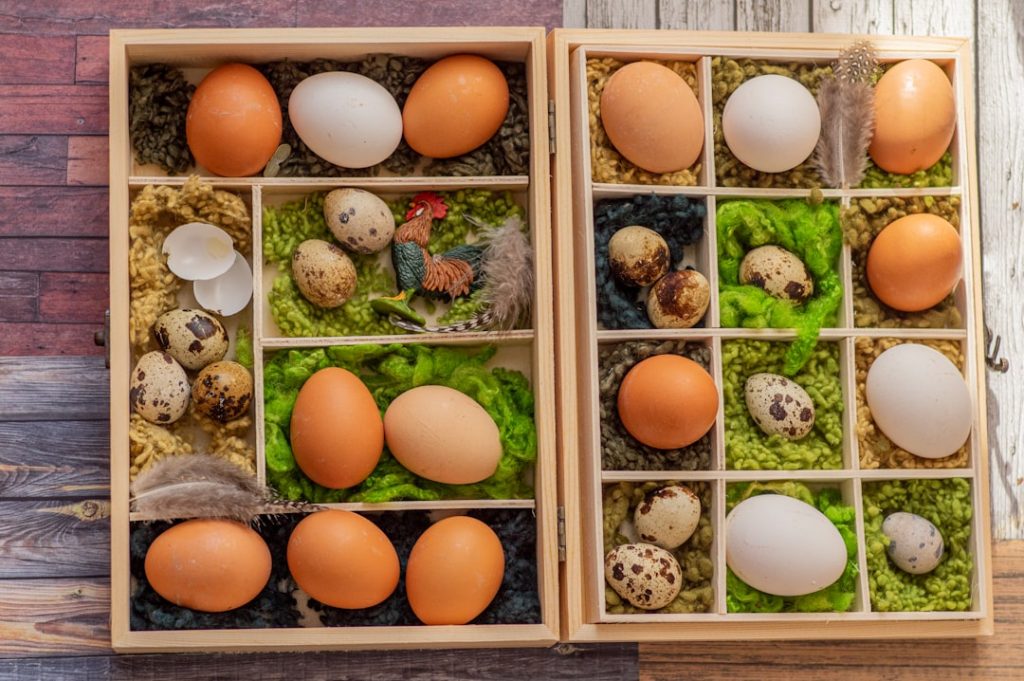Jumbo Coturnix quail, also known as Pharaoh quail, are a popular breed of quail that are raised for their meat and eggs. They are larger than the standard Coturnix quail, making them a desirable choice for those looking to raise quail for commercial purposes. Jumbo Coturnix quail are known for their fast growth rate, reaching maturity in just 6-8 weeks, and their ability to lay a large number of eggs. They are also relatively easy to care for, making them a great option for beginners and experienced breeders alike.
Jumbo Coturnix quail are known for their calm and docile nature, making them easy to handle and work with. They are also relatively quiet birds, making them a good choice for those who live in urban or suburban areas. These quail are also known for their high fertility rates, making them a great choice for those looking to breed quail for profit. Overall, Jumbo Coturnix quail are a versatile and practical option for those looking to raise quail for meat and eggs.
Table of Contents
- 1 Selecting Breeding Stock
- 2 Breeding Environment and Housing
- 3 Breeding Techniques and Practices
- 4 Incubation and Hatching
- 5 Caring for Chicks and Young Quail
- 6 Marketing and Selling Jumbo Coturnix Quail
- 7 FAQs
- 7.1 What is the breeding process for jumbo coturnix quail?
- 7.2 What is the ideal environment for breeding jumbo coturnix quail?
- 7.3 What should be included in the diet of breeding jumbo coturnix quail?
- 7.4 How long does it take for jumbo coturnix quail eggs to hatch?
- 7.5 What are some common challenges in breeding jumbo coturnix quail?
Key Takeaways
- Jumbo Coturnix quail are a larger breed of quail known for their fast growth and high meat and egg production.
- When selecting breeding stock, look for healthy birds with good size, strong legs, and a calm temperament.
- The breeding environment and housing should provide enough space, proper ventilation, and protection from predators.
- Breeding techniques include providing a balanced diet, monitoring mating behavior, and ensuring proper egg collection and storage.
- Incubation and hatching require a stable temperature, humidity, and regular turning of the eggs for successful hatching.
- Caring for chicks and young quail involves providing warmth, proper nutrition, and protection from predators.
- Marketing and selling Jumbo Coturnix quail can be done through local markets, online platforms, and direct sales to restaurants and consumers.
Selecting Breeding Stock
When selecting breeding stock for Jumbo Coturnix quail, it is important to choose birds that are healthy, strong, and have desirable traits. Look for birds that are free from any signs of illness or disease, such as lethargy, labored breathing, or abnormal droppings. It is also important to choose birds that are of good size and weight, as this will ensure that they produce offspring that are suitable for meat production. Additionally, look for birds that have a calm and docile temperament, as this will make handling and caring for them much easier.
When selecting breeding stock, it is also important to consider the genetic diversity of the birds. Avoid breeding birds that are closely related, as this can lead to genetic abnormalities and health issues in the offspring. Instead, aim to select birds from different bloodlines to ensure genetic diversity and strong, healthy offspring. Finally, consider the egg production of the birds when selecting breeding stock. Look for birds that have a history of laying a large number of eggs, as this will ensure a steady supply of eggs for consumption or sale.
Breeding Environment and Housing
Creating the right breeding environment and housing for Jumbo Coturnix quail is essential for their health and productivity. When it comes to housing, it is important to provide enough space for the quail to move around comfortably. A good rule of thumb is to provide at least 1 square foot of space per bird. This will help prevent overcrowding and reduce the risk of aggression and stress among the birds. Additionally, make sure the housing is well-ventilated to prevent the buildup of ammonia from the birds’ droppings.
The breeding environment should also include nesting boxes or areas where the quail can lay their eggs. These boxes should be filled with clean bedding material, such as straw or wood shavings, to provide a comfortable and sanitary environment for the birds to lay their eggs. It is also important to provide a balanced diet for the quail, including a high-quality commercial feed and access to fresh water at all times. Finally, make sure the breeding environment is kept clean and free from any potential hazards or predators that could harm the quail.
Breeding Techniques and Practices
Breeding Jumbo Coturnix quail requires careful attention to detail and proper breeding techniques. One important aspect of breeding is ensuring that there is a proper ratio of males to females in the breeding flock. A good rule of thumb is to have one male for every four to six females. This will help prevent aggression among the males and ensure that each female has a chance to mate and produce fertile eggs.
Another important breeding technique is providing the right conditions for mating and egg production. This includes providing a suitable nesting area with clean bedding material, as well as ensuring that the birds have access to a high-quality diet and fresh water. It is also important to monitor the breeding flock regularly for any signs of illness or injury, as this can impact their ability to breed and produce healthy offspring.
Incubation and Hatching
Once the eggs have been laid by the breeding flock, it is important to collect them promptly and store them in a cool, dry place until they are ready for incubation. When it comes to incubating Jumbo Coturnix quail eggs, it is important to use a reliable incubator that can maintain a consistent temperature and humidity level. The eggs should be placed in the incubator with the pointed end facing downward, and they should be turned several times a day to ensure even heat distribution.
After about 17 days of incubation, the eggs will begin to hatch. It is important to closely monitor the hatching process and provide assistance to any chicks that may be struggling to hatch on their own. Once the chicks have hatched, they should be carefully removed from the incubator and placed in a warm brooder with access to food and water.
Caring for Chicks and Young Quail

Caring for Jumbo Coturnix quail chicks requires attention to their specific needs during the early stages of development. It is important to provide a warm brooder with a heat source such as a heat lamp or heating pad to keep the chicks warm during their first few weeks of life. The brooder should also be equipped with clean bedding material, such as paper towels or pine shavings, to provide a comfortable and sanitary environment for the chicks.
In addition to warmth and bedding, it is important to provide the chicks with a high-quality starter feed that is specifically formulated for young quail. This feed should be supplemented with fresh water at all times to ensure that the chicks stay hydrated and healthy. It is also important to monitor the chicks closely for any signs of illness or injury, and provide prompt medical attention if needed.
Marketing and Selling Jumbo Coturnix Quail
Once your Jumbo Coturnix quail have reached maturity, you may choose to sell them for meat or eggs. When marketing your quail meat or eggs, it is important to highlight the benefits of Jumbo Coturnix quail, such as their fast growth rate, high egg production, and delicious meat. Consider selling your products at local farmers’ markets, through online platforms, or directly to restaurants or grocery stores.
When selling Jumbo Coturnix quail meat, it is important to comply with any local regulations regarding meat processing and sales. This may include obtaining the necessary permits and certifications, as well as following proper food safety practices. When selling quail eggs, it is important to ensure that they are clean and properly packaged to maintain their freshness and quality.
In conclusion, raising Jumbo Coturnix quail can be a rewarding endeavor for those looking to produce meat and eggs on a small scale or as a commercial venture. By understanding their unique characteristics, selecting quality breeding stock, providing a suitable breeding environment, implementing proper breeding techniques, caring for chicks and young quail, and effectively marketing and selling their products, breeders can successfully raise Jumbo Coturnix quail for profit and enjoyment.
If you’re interested in breeding jumbo coturnix quail, you may also want to consider the housing options for your birds. A well-designed coop can make a significant difference in the success of your quail breeding venture. Check out this informative article on the benefits of a Snaplock Chicken Coop from Poultry Wizard. The article provides valuable insights into how a well-constructed coop can contribute to the health and productivity of your quail flock. Learn more about Snaplock Chicken Coop here.
FAQs
What is the breeding process for jumbo coturnix quail?
The breeding process for jumbo coturnix quail involves providing a suitable environment for mating, ensuring proper nutrition, and managing the incubation of the eggs.
What is the ideal environment for breeding jumbo coturnix quail?
The ideal environment for breeding jumbo coturnix quail includes a spacious and clean enclosure with proper lighting, ventilation, and temperature control. It is important to provide nesting areas and privacy for the quail to mate and lay eggs.
What should be included in the diet of breeding jumbo coturnix quail?
The diet of breeding jumbo coturnix quail should include a balanced mix of high-quality quail feed, fresh water, and occasional treats such as mealworms or greens. It is important to provide adequate levels of protein and calcium for egg production.
How long does it take for jumbo coturnix quail eggs to hatch?
Jumbo coturnix quail eggs typically take 17-18 days to hatch once they have been incubated at the proper temperature and humidity levels.
What are some common challenges in breeding jumbo coturnix quail?
Common challenges in breeding jumbo coturnix quail include maintaining optimal breeding conditions, preventing egg infertility, and managing the health and well-being of the quail and their offspring. It is important to be vigilant for signs of disease and to provide proper care and nutrition.
Meet Walter, the feathered-friend fanatic of Florida! Nestled in the sunshine state, Walter struts through life with his feathered companions, clucking his way to happiness. With a coop that’s fancier than a five-star hotel, he’s the Don Juan of the chicken world. When he’s not teaching his hens to do the cha-cha, you’ll find him in a heated debate with his prized rooster, Sir Clucks-a-Lot. Walter’s poultry passion is no yolk; he’s the sunny-side-up guy you never knew you needed in your flock of friends!







